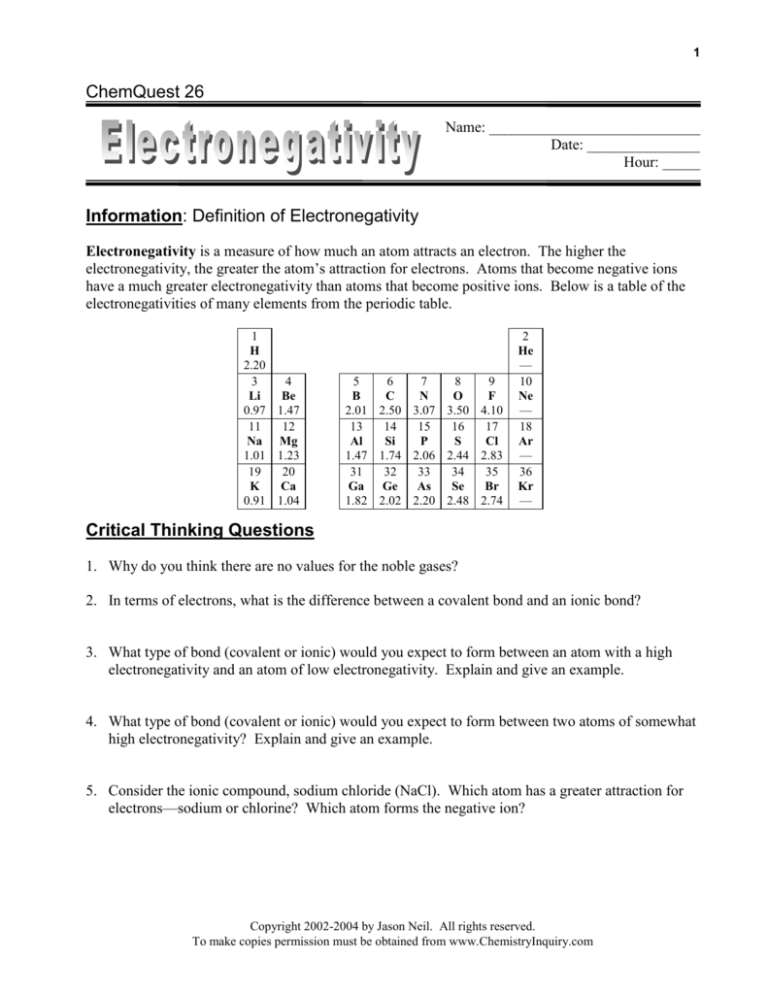
1
ChemQuest 26
Name: ____________________________
Date: _______________
Hour: _____
Information: Definition of Electronegativity
Electronegativity is a measure of how much an atom attracts an electron. The higher the
electronegativity, the greater the atom’s attraction for electrons. Atoms that become negative ions
have a much greater electronegativity than atoms that become positive ions. Below is a table of the
electronegativities of many elements from the periodic table.
1
H
2.20
3
4
Li
Be
0.97 1.47
11
12
Na Mg
1.01 1.23
19
20
K
Ca
0.91 1.04
5
6
7
8
9
B
C
N
O
F
2.01 2.50 3.07 3.50 4.10
13
14
15
16
17
Al
Si
P
S
Cl
1.47 1.74 2.06 2.44 2.83
31
32
33
34
35
Ga Ge
As
Se
Br
1.82 2.02 2.20 2.48 2.74
2
He
—
10
Ne
—
18
Ar
—
36
Kr
—
Critical Thinking Questions
1. Why do you think there are no values for the noble gases?
2. In terms of electrons, what is the difference between a covalent bond and an ionic bond?
3. What type of bond (covalent or ionic) would you expect to form between an atom with a high
electronegativity and an atom of low electronegativity. Explain and give an example.
4. What type of bond (covalent or ionic) would you expect to form between two atoms of somewhat
high electronegativity? Explain and give an example.
5. Consider the ionic compound, sodium chloride (NaCl). Which atom has a greater attraction for
electrons—sodium or chlorine? Which atom forms the negative ion?
Copyright 2002-2004 by Jason Neil. All rights reserved.
To make copies permission must be obtained from www.ChemistryInquiry.com
2
6. In an ionic bond, the atom with the highest electronegativity will always form a
________________________ ion.
(positive or negative)
7. Consider the covalent compound, carbon monoxide (CO).
a) Draw the Lewis dot structure for carbon monoxide.
b) In the Lewis structure you drew, you should see that there is a triple bond between carbon and
oxygen. The carbon and oxygen share 6 electrons. All 6 electrons are not shared equally,
however, because carbon and oxygen don’t have equal attraction for electrons. The 6
electrons spend a little more time near one of the atoms—predict which one and explain.
8. Why are the electrons in a nitrogen-phosphorus covalent bond NOT shared equally? Which atom
do the electrons spend more time around? Explain.
9. True or false: In an ionic bond, the difference in electronegativities between the two bonding
atoms is greater than the difference in a covalent bond.
10. In terms of electronegativity, explain why this statement is true: “Carbon monoxide is more
‘ionic’ than carbon monosulfide”.
11. Which bond is more like an ionic bond—a nitrogen-oxygen bond or a carbon-oxygen bond?
Explain.
12. Which compound is more like an ionic compound—NH3 or PH3? Explain.
Information: “Polar” Bonds
In critical thinking questions 10, 11, and 12 we used the term “ionic” when describing covalent
bonds. This can get confusing and so instead of the term “ionic” we will use the term “polar”. A
polar covalent bond then is a covalent bond in which the electrons are not shared equally by the two
atoms involved in the bond. For example, in carbon monoxide the electrons spend more time near
oxygen than carbon because oxygen has a greater electronegativity. Because of oxygen’s greater
electronegativity, it attracts the electrons more than carbon.
Copyright 2002-2004 by Jason Neil. All rights reserved.
To make copies permission must be obtained from www.ChemistryInquiry.com
3
Critical Thinking Questions
13. Which bond is more polar—a phosphorus-chlorine bond or a phosphorus-fluorine bond? Explain
why.
14. Consider a carbon-fluorine bond. One atom in the bond is “partially negative” and the other atom
is “partially positive”. Which atom is which? Explain how you know.
15. In your own words explain what you think the term “partially negative” means and explain why
an atom might be partially negative when it bonds covalently. (I.e. What makes it partially
negative?)
16. In your own words explain what you think the term “partially positive” means and explain why
an atom might be partially positive when it bonds covalently. (What makes it partially positive?)
Information: Polar vs. Nonpolar
Not all covalent compounds are categorized as polar. For example, a carbon-hydrogen bond is made
up of two atoms that have very similar electronegativities. Because of this, carbon and hydrogen
share the electrons just about equally and we say that a carbon-hydrogen bond is “nonpolar”. As a
general measure, if the difference in electronegativity between two bonding atoms is less than about
0.5, then the bond is nonpolar.
Critical Thinking Questions
17. For the following bonds, indicate whether they are ionic (I), polar covalent (P), or nonpolar
covalent (NP).
_____ a) C—P
_____ b) S—O
_____ c) Fe—O
_____ d) N—H
18. What are the three most electronegative atoms on the periodic table?
Copyright 2002-2004 by Jason Neil. All rights reserved.
To make copies permission must be obtained from www.ChemistryInquiry.com







